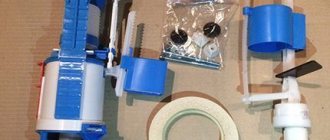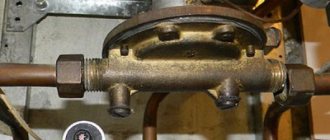How much irritation, headache, and inconvenience causes water that appears on the floor near the toilet! We wonder: what could be leaking in the simplest form of plumbing? We think: is this a serious breakdown or a minor violation? And when we find that the gasket between the tank and the toilet is damaged, we call the plumbers. It is so?
With our help, you can easily deal with the problem yourself. We will introduce you to the specifics of using gaskets of different configurations. Independent home craftsmen who are not afraid of any work will find here a detailed description of the procedure for laying and fixing the seals located between the toilet and the cistern.
The valuable tips we offer will help novice plumbers. The article outlines the principle of replacing the gasket, touches on technical nuances, and gives recommendations to ensure a successful result. Photos and videos are a good help to facilitate the perception of information.
How to properly install a gasket between the tank and the toilet?
Mikhail How to install a gasket between the tank and the toilet?
Safe and comfortable operation of the toilet and cistern is impossible without a special gasket - it is responsible for the tight connection of the two plumbing fixtures. If a part is installed incorrectly, not changed regularly, or not used at all, leaks cannot be avoided. Therefore, below we will tell you how to correctly install the gasket and what installation points to pay special attention to.
Stage 1: Dismantling the plumbing
First you need to disassemble the plumbing equipment:
- Close the water supply valve. Drain the water from the tank - the device must be completely empty.
- Carefully disconnect the tank from the base of the toilet bowl: open the tank, remove the inner pipe and remove the siphon locknut.
- Unscrew the screws connecting the tank and toilet into the overall structure.
At this stage, the biggest difficulty may be in dismantling the fasteners. Especially if the plumbing fixtures have been in use for more than a year. The fact is that all kinds of screws and nuts for the toilet and cistern are made not of polymers, but of metal, which over time, as expected, corrodes and becomes covered with rust. Unscrewing them manually is very difficult, and sometimes even impossible.
Replacing the toilet cistern gasket
There are several solutions to this problem:
- Cleaning threads and fasteners. Depending on the level of corrosion, use either a special rust remover or regular car oil. A stiff brush is suitable as a working tool.
- Replacing fasteners. Using a grinder or hacksaw, saw off the old nuts and screws.
Important! Work very carefully to avoid breaking fragile plumbing fixtures.
Stage 2: Install the gasket
When the plumbing has been disassembled and access to the gasket is ensured, you can proceed to the second stage - the direct installation of a new product. The gasket is placed at the junction of the toilet and the flush cistern - carefully remove the old part and thoroughly clean the working surface from dirt, corrosion and various deposits. Next, install a new gasket.
Then assemble the plumbing: insert the screws into their holes, install the tank and carefully tighten the fasteners. Tighten the screws sequentially. Make sure that the tank is as level and strong as possible, but do not overdo it when tightening the screws, otherwise the toilet may burst.
After completing all installation work, wait an hour or two until the silicone sealant completely hardens. Next, open the water supply valve, fill the tank with water and check for leaks.
As you can see, installing a gasket between the toilet and the tank is an easy job and extremely important for trouble-free use of the appliances. Be sure that by spending very little time, you will definitely minimize the risk of leaks for a long period of use of the plumbing.
How to fix a toilet: video
Replacement procedure
The operation of updating the gasket is not so complicated that a person completely unfamiliar with plumbing could not cope with it. In order to correctly change the sealing element under the toilet tank, first of all you should consider how to attach it to the base of the bowl.
Note! Based on this feature, all systems are divided into two types: the first involves fixing the tank for drainage on a special shelf, and the second is characterized by an independent position of the fastening zone.
On the shelf
The cuff is mounted on the shelf of the bowl base. The advantage of this arrangement is the compactness and ease of maintenance of the compaction area.
Note! This method is not without some disadvantages, manifested in the low pressure of the drained liquid.
Before you remove the old one and start installing the new gasket, you should first turn off the water supply valve and disconnect the supply hose from the tank.
Then the water is completely drained from it (you can use a special valve for this), and then the mounting bolts are removed. When disassembling the bolted joint, you need to act very carefully, trying not to damage the fragile porcelain (otherwise it may simply crack).
The next step is to remove the tank and dismantle the seal that has become unusable.
Before installing the new cuff, a layer of silicone sealant should be applied to the base of the toilet, which will help fix it and prevent it from moving too much to the side.
Separate location
Such a toilet has one advantage, which is the strong pressure of the flushed water supply. In it, the drain pipe is attached to the bowl of the model and is sealed inside the structure in one way or another, depending on the shape of the receiving neck.
Most often, it has an extension with a cap collar, which ensures reliable articulation of the two parts built into the monolith. One of the variations of this option is the use of special petal-type transition cuffs.
These products look like rubber couplings with a wide outer diameter that matches the cross-section of the flush pipe with the inner neck. When installing such a joint inside the structure, all its elements are lubricated with a layer of sealant.
Gasket functions
The first and main function of the gasket is to seal the intermediate connection between the tank and the toilet.
The second is a damper that absorbs shock loads. The toilet body is made of ceramic, which is shock resistant. During operation, a person may lean on the tank or during installation carelessly place it on the toilet. Rubber or silicone softens shocks and prevents chips, cracks, and destruction of the tank or toilet.
The industry produces several types of seals:
- rubber;
- silicone;
- polyurethane.
Manufacturers of plumbing fixtures, based on the design features of toilets, produce gaskets of various shapes, thicknesses, colors, and materials used.
By shape
The shape of the gaskets can be round, oval, trapezoidal or polygonal. To improve the tightness in the section, the gaskets can be conical or rectangular.
Round
Round gaskets are the most common due to their manufacturability. Complex molds are not needed to produce them.
Oval
Oval ones are rarely used due to the complexity of manufacturing and mounting on the toilet body. If 2 fastening screws are enough for round gaskets, then 3 or more are needed for oval gaskets. They require the screws to be tightened evenly without distortion.
Trapezoidal
Trapezoidal ones are rarely used due to their large size and difficulty in tightening evenly. It not only seals the connection, but plays the role of a damper between the tank and the bowl. Such gaskets are used in products from TM SANITA. Some systems use trapezoidal gaskets together with round ones. Trapezoidal ones play the role of a damper and additional seal, while round ones directly seal the connecting unit between the tank and the bowl.
Universal
Universal ones combine two functions: sealing and damping. They have a complex cross-section to ensure a seal between the cistern and the toilet plus a hexagonal outlet.
Types of connection
First, you need to decide which system to include the device in:
- Connecting a heated towel rail to the heating system. The traditional method and the only one where there are no hot water networks. Its disadvantage is that the heating system only works in the winter season. The advantage is that water circulation in the heating pipeline is forced and the heated towel rail will be hot throughout the heating season, acting as an additional battery.
- Connecting a water heated towel rail to the hot water supply system. Such systems are also subject to outages, but for a shorter period. In addition, the disadvantage of this method is that the unit will heat up only during the consumption of hot water, cooling down at night, even when connected directly to the riser. In small apartment buildings or private houses, this problem is even more acute.
The installation diagram and connection of the heated towel rail to the hot water riser in the bathroom looks like this:
As already noted, the optimal solution to many problems is the use of combined devices. operating from the mains in the absence of hot water in the system.
After choosing a pipeline network for our device, the next question arises about how to include it in it:
- Direct insertion into the riser. If the bathroom was already equipped with a heated towel rail, then it is connected to the heating pipe in this way. By replacing it with a new one, you can, without further ado, use the same type of connection. You can also embed the new device directly into the hot water riser.
- Inclusion in the apartment pipeline. The advantage of this method is that when carrying out work it is not necessary to shut off the entire riser, but it is more suitable for a heating system. The above problem with the hot water pipeline will be further aggravated: the device will heat up only when washing dishes, taking a shower or bath.
With bypass jumper
Heated towel rails in old houses, as already mentioned, were a direct part of the heating pipe. Such a connection creates problems in the event of an accident or repair and does not make it possible to turn off the device when it is not needed.
Therefore, the most reasonable thing to do when installing a new device would be to insert a bypass jumper and shut-off valves parallel to it into the riser. to which it joins. This useful addition to the pipeline should be included in the connection diagram.
How to replace the gasket
Removing the tank
So, if you find that the gasket has worn out and requires replacement, you should not rush to call a technician; you can easily change it yourself.
Replacement begins by dismantling the tank:
- Shut off the water supply to the toilet cistern.
- Drain all the water from it and remove the remaining water from the bottom, since when removed, the remaining water will simply spill out onto the floor.
- Disconnect the water supply pipe from the tank.
Disconnecting the water supply pipe from the toilet tank
- Unscrew the screws from the studs of the tank that attract it to the toilet.
Disconnecting the tank from the toilet by unscrewing the screws from the studs
- If necessary, unscrew the tank fittings.
- Remove the tank from the toilet and remove the gasket.
Replacing the gasket and installing the tank
After purchasing a new similar gasket based on the sample, they proceed to its installation:
- The places on the tank and toilet where the previous cuff stood are thoroughly cleaned of dirt and possible lime deposits, and wiped dry.
- Place the gasket on the seat of the tank or toilet, depending on the type of plumbing fixtures and seal.
Putting a new gasket on the tank
- Place the tank in place, making sure that the sealing collar does not “move out”.
Putting the tank on the toilet with a new gasket
- Attach the tank to the toilet by screwing the screws onto the studs. The screws should be tightened evenly, otherwise, if you tighten one of the screws all the way at once, there is a risk of the gasket being skewed and partially dislodged from the seat. The screws must be tightened firmly. If the gasket is thick, when tightening, you can even lightly press the tank from top to bottom and tighten the screws more tightly. This way you can avoid leaks where the tank meets the toilet and water dripping.
Attaching the tank to the toilet using screws
- If necessary, install fittings in place.
- Connect the water supply pipe to the tank and perform a test run, checking that there are no leaks anywhere.
It may be necessary to tighten the screws on the studs after a couple of days, since the thick gasket may shrink under the weight of the tank.
Thus, we identified the types of gaskets at the junction of the tank and the toilet, recommended how and which ones are better in a given situation, and figured out how to replace the seal with your own hands. Despite all this, we advise you to still waterproof the floor in the toilet and bathroom, and sleep peacefully, without fear that you will flood your neighbors below. Good quality repairs to you!
Causes of leakage
To establish the causes of the leak and eliminate it, you must first clearly identify the place where the leak is. Such leaks can be internal or external. Let's look at it in order.
Leak inside
Such a leak manifests itself in the constant flow (of greater or less intensity) of water through the drain valve or overflow pipe of the tank directly into the toilet. This leak is harmless but wastes water. Such a low-intensity leak can be visually identified by a thin stream of water that constantly flows through the toilet.
Options for troubleshooting this problem:
- Change the gaskets between the shut-off valve and the seat.
- clean the area where it adjoins the seat.
- raise the level of the overflow tube.
- adjust the float and filling valve system.
- Replace the fill valve and float.
Advice! In most of these cases, water flows through the overflow tube, so you need to start repairs by adjusting the water level in the tank.
A properly adjusted system closes the fill valve when the water level in the tank is below the top edge of the overflow tube. As a rule, this is enough to eliminate such a leak.
Wet outside
If you have water on the floor under the toilet, you should take a very responsible approach to finding out where it is leaking and for what reasons. With some faults of this type there is a significant risk of a major flood. According to the law of meanness, this usually happens at night or in your absence, so it causes maximum harm.
There may be nothing wrong with your tank at all. Simply due to the temperature difference between the water entering the tank and the room, quite powerful condensation can form, which flows onto the floor and forms puddles.
This effect is observed in cold weather with intensive drainage - the water is constantly renewed and does not have time to warm up.
To eliminate this phenomenon, you can install a partial drainage system - half the volume of the tank is poured out at a time. The incoming cold water is mixed with warm water and much less condensation is formed.
Another reason is a severe internal leak. Remedies are described in the previous chapter.
Leak in flexible hose.
Probably the most dangerous defect that can lead to catastrophic consequences.
If, upon inspection, you find that water is flowing from the water supply connection, then you need to tighten it or replace the gaskets in it.
Flexible rubber hoses with external reinforcement are usually of rather low quality. Over time, in addition to cracks on the hose itself, the bushings into which this hose is pressed also become subject to corrosion, so there is a possibility that when the gasket is pressed, the fitting will be torn off and a fountain will occur. And this is not the worst option; the fitting may burst even in your absence.
Advice! Don’t take risks - replace such hoses with special plastic, metal-plastic connections or stainless steel tubes.
Leaking from under the tank.
Another type of external leak. It occurs when the seal between the tank and the toilet is broken. The intensity of such a leak depends on the degree of damage and can be quite dangerous.
There are two main types of connection between the cistern and the toilet - a hanging cistern connected by a pipe to the toilet drain hole and a cistern installed directly on its bowl. Let's consider options for eliminating leaks in the second, modern type of installation.
Loosening of fastening threaded connections. When installing a tank on steel threaded rods, corrosion occurs over time, even to the point of destruction. In this case, distortions and, accordingly, the appearance of cracks and leaks are possible.
If you find such a defect, you need to replace the fasteners and, if necessary, the seal between the tank and the toilet.
Damage or physical wear of the rubber sealing gasket.
Rubber is a material that is not particularly resistant to changes and temperature fluctuations, so over time it loses its plasticity and becomes covered with cracks and potholes. Such a gasket can no longer reliably perform its functions and must be replaced with a new one.
Crack, cracks on the body of the tank and or toilet.
Quite rarely, but still there are cases when, during unprofessional installation, usually due to excessive tightening of the fasteners, cracks appear on the earthenware. This situation is very unpleasant and its solution is to replace the cracked device with a new one.
Advice! The drainage system is a low-pressure system, and therefore does not require increased strength of connections.
If the cracks are small and do not significantly affect the strength of the structure, you should try to seal them with silicone sealant. To do this, you need to thoroughly clean, degrease the area being treated and apply a layer of sealant to it from the inside. A strip of small mesh plaster mesh additionally reinforces such a seam.
Nuances of installing seals
There are usually no special nuances for installing gaskets between the flush cistern and the toilet bowl. The exception is rare models of plumbing fixtures that are far from the standard configuration. As a rule, the seal is inserted (placed) inside the landing recess intended for it in the mating area.
After that, the drain tank is carefully placed at the installation site so that the holes for the mounting hardware on the tank and the bowl stand are aligned. It is important here not to displace the gasket from the seating area when installing the tank.
It is somewhat easier to mount the filling tank on the toilet bowl stand when gaskets of the M60 and KK100 types are used. This rubber seal fits with a slight tension onto the fastening nut of the drain mechanism. Therefore, the risk of displacement of the M60 (KK100) gasket during installation is practically reduced to zero.
Step-by-step instructions for disassembling the drain tank for repair work are given here. In the article we recommend you will find many valuable recommendations.
Tank-bowl intermediate gasket
Some models of household toilets are made to connect the filling tank with the toilet bowl through an additional intermediate gasket. If it is included in the plumbing kit, the easiest way to install it is by first attaching the mounting screws to the threaded rods.
Intermediate seals traditionally have “ears” with holes through which the mounting screw rods pass. If you install the intermediate seal in place, aligned with the mounting holes, and then try to install the tank, the gasket can easily be moved out of place. Therefore, simply attaching it to the screws simplifies the installation procedure.
Screed torque
It would seem that there is nothing simpler than tightening the connection parts with screws after all the manipulations with the gaskets. Meanwhile, the fastening procedure also has its own characteristics. The nuts should be screwed onto the threads of the bolted studs evenly, by about 2-3 threads, alternately applying the action to the bolted joints.
The dismantling and reinstallation procedure is also carried out if the tank does not hold water. Those. if it is necessary to replace the fittings responsible for drawing and draining water from this plumbing container.
The tightening force must be calculated correctly. There is no need to retighten bolted connections when the gasket is already securely tightened. Moreover, re-tightening is not recommended for connections where polypropylene screws are used. And to ensure guaranteed reliability, it is reasonable to replace plastic fastening accessories with metal products.
Testing the installed gasket
The procedure for testing gaskets (checking the reliability of tightness) is a mandatory part of the installation. The test does not require any special metalworking procedures.
After completing the installation work, it is enough to fill the toilet tank two-thirds with water by briefly opening the shut-off valve. In this condition, the plumbing fixture should be carefully inspected in the area where the sealing rubber is located. The first test is considered passed if no obvious water leaks are detected.
The second test will take some time - at least half an hour. It is necessary to fill the tank to the full level (the limit level of the drain mechanism) and keep it in this state (for half an hour or an hour).
Then take a piece of toilet paper and thoroughly wipe the areas of the toilet close to the area where the gasket is installed. Similar actions must be performed both on the top side and below. Is the paper dry? In this case, you can put the plumbing into operation.
If, after the second check, the toilet paper becomes damp (even partially), these symptoms indicate a poor seal. You shouldn’t rely on “maybe” here. The correct solution is to redo the installation of the filler tank and correct the installation of the sealing gasket. In this case, it is desirable to determine the causes of the leak.
It often happens that water on the floor next to the toilet is not at all the cause of its leak. This is the tank “sweating”. We advise you to familiarize yourself with the reasons for the appearance of condensation on its surface and with methods for eliminating unwanted moisture.
The principle of complete tightness
Why is it necessary to ensure complete tightness of the system when installing the filler tank to the toilet bowl? The requirements are explained simply. Even a small leak leads to the formation of pockets of dampness. And dampness is the optimal environment for microbial growth.
A slight (unnoticeable) water leak contributes to the formation of water stone. This substance has a negative effect on rubber - it deforms individual sections of the gasket. As a result, the operation of the device results in emergency leaks. Such accidents can occur at any time, including when home owners are away.
First aid
Since gaskets are most often made from rubber, there are many concerns about their durability.
It is no secret that with constant contact with moisture, rubber products gradually lose their elasticity, harden, and begin to crack. And even small cracks can see water, which is the first cause of gasket damage. You can understand that the seal has become unusable based on several signs.
- The appearance of liquid on the floor covering of the restroom. If the liquid has nothing to do with the formation of condensation on the toilet tank in the winter, as well as with valve leakage, then this is a leak associated with the unsuitability of the gasket.
- A visual inspection of the seal showed obvious damage. To carry out this operation, you must completely remove the tank from the toilet. If the inspection does not reveal any visible damage, it is necessary to feel the gasket. If the part is too rigid, it is better to replace the seal.
How to choose?
To buy a new toilet gasket, you need to go to a plumbing store . Most of them feature common models of elastic bands of different sizes, made of rubber or silicone. Polyurethane gaskets can be purchased at an official dealer's store, depending on the installed toilet model of a particular manufacturer.
It is better if the gasket is original, made by the same manufacturer as the toilet. But if the original model is not available, then you can purchase a universal gasket. Universal seal models are most often presented on the market by Santek or Cersanit. Gaskets of these brands are made from high-quality materials and are suitable for most toilet models.
You need to select the right rubber band according to the sample or the name of the toilet model. When purchasing, you should pay attention to a number of important points.
- Exact match with the sample or model of plumbing fixtures. Even a slight deviation from the original sample can lead to a loose fit, which will lead to leaks.
- No damage or scratches on the surface of the product. When purchasing, you should slightly stretch the gasket and squeeze it between your fingers. If a spare part is hard to the touch or has a manufacturing defect, you should refuse to purchase it.
Installation of an electric heated towel rail
The main advantage of an electric heated towel rail is ease of installation. Like any wall-mounted electrical appliance, it needs to be hung on the wall and connected to the power supply. All that remains is to turn on the device itself and use it for its intended purpose.
An important requirement is compliance with electrical safety rules
Such a device should be connected only through a so-called “automatic machine” or RCD - residual current device. If the socket for connecting the device will be installed directly in the bathroom, be sure to use a special device protected from moisture.
This socket is mounted in the thickness of the wall and has a special cover. In addition, the electrical appliance must be grounded.
It is believed that the option with an electric heated towel rail is not economically profitable compared to water models, as it increases heat bills. However, the power of such devices is not so great, as is the electricity consumption.
This is quite enough to dry wet terry cloth, but it does not cope very well with the role of a bathroom heater.
The choice is yours!
How to choose
When it comes to choosing and replacing a gasket, many people get confused, since you can find many different parts in a plumbing store. They can be made of rubber, silicone or polyurethane, and come in different shapes and lengths. Often there are identical products with the same dimensions from different manufacturers. To ensure that the selected sealing element meets your expectations, you need to follow several rules:
- the product must be made of an elastic material that is sufficiently soft and elastic;
- the shape must correspond to the toilet model on which the new gasket will be installed;
- The seal must be free of defects. Sometimes sellers offer customers parts that are already dry and unsuitable for use. Make sure there are no cracks or sagging on the gasket.
Remembering the product in your hands before purchasing is the best way to evaluate the elasticity and flexibility of the product without risking damage to it. If you are not sure which part you need, dismantle the toilet, remove the old gasket and bring it to the store as a sample.
If you are making a choice between a cheap domestic or expensive imported gasket, think about the ratio of quality and price. More expensive seals can last longer and be of better quality, although they will cost more.
Tips for attaching adapters
Before choosing a cuff, be sure to check the distance from the toilet outlet to the sewer pipe. Sometimes the installation process is disrupted only because the length of the eccentric is 2 cm less than necessary.
If you choose a corrugated pipe, check the degree of stretch. It may not be enough for a complex connection case or connection to a pipe located at a long distance
Elongated corrugation is prone to sagging, so additional fasteners will be required to give it a straight look. Sharp corners and strong bends are the causes of frequent blockages.
In addition to the length and shape of the cuffs, pay attention to the thickness of the walls. The higher this indicator, the longer the device will last.
Before purchasing plumbing fixtures, analyze the condition of the sewer system, and then you can choose a model with the desired type of outlet and decide on the toilet installation scheme.
Temporary troubleshooting
It happens that a leak is discovered, but a new gasket for the toilet tank is not available. In this case, you can try using one of two solutions to the problem :
- Cut a small strip from the fabric and coat it with a little hardened oil paint. For further actions, you will need an assistant : he will lift the drain tank, and in the meantime you will wrap the worn part with a prepared fabric strip.
It is advisable to tie it with twine on top to increase strength . After this, you need to lower the tank, secure all the necessary elements on it and do not fill it with water until the paint is completely dry. You can buy a rubber band at the pharmacy. Its length should be 1 m, width - 0.5 cm, and thickness - 1-2 mm . While stretching it, you should wrap the worn part without removing it from the pipes. The tape is fixed using copper wire.
When carrying out repairs in this way, you do not need to use paint and lift the tank , therefore, you can do it yourself, without an assistant.
You can use a pencil to push the end of the rubber band through. Using a screwdriver in this case is not very convenient, since it has a handle. Thus, replacing a worn part is not a particularly difficult job, which can be done independently. To do this, it is not necessary to invite a plumber .
It is only important to choose the right product that is exactly suitable for your toilet. Then the repair will be effective, the leak will stop, and you can use the plumbing fixture to its full potential.
Type of connecting part
Toilet design.
Sometimes the breakdown is caused by external faults. This is especially true for those in which the flush cistern is connected to the neck of the toilet using a rubber cuff, which dries out and cracks after a certain period of use. This part cannot be repaired, only replaced.
The toilet cuff is a sealed connecting piece. The main task of this part is to connect the toilet with a pipe that drains domestic and household wastewater into the sewer system. This part is produced in various sizes and can be either straight or eccentric.
The cuff consists of two cylindrical surfaces that are joined together. Their longitudinal axes can be shifted relative to each other. This eccentricity is needed when its outlet and the inlet pipe of the sewer pipe do not coincide with each other. For various installation options for the toilet, a long connecting part and a short one are produced.
Stages of toilet installation.
Another type of connecting part is a corrugated cuff. The versatility of this part manufacturing option lies in the possibility of using it in particularly complex toilet installation options. The corrugation allows you to perform the necessary maneuver on the area of the bathroom, installing it at any angle, and also allows you to move the toilet to a place convenient for you. The main thing to remember when using corrugation is that the required slope must be made.
It is very easy to detect water leakage from under the cuff or directly through it. To do this, you need to place one palm under the connecting piece, and with the other hand simply press the tank release mechanism. If water spills into your palm, it means the cuff has become unusable. It would be good if it was simply pulled off the neck of the toilet by a lopsided one. Fixing such a leak is quite easy. To do this, you need to position and support the tank with some kind of stand and then tighten the nuts of the screws that connect the toilet and the shelf. After this, we pull the cuff back into place. For a more reliable fixation, you can secure it with wire.
Video description
Installation of a wall-hung toilet.
Further actions are arranged as follows:
- The water is shut off and a flexible metallized hose is installed at the entry point, which will be responsible for collecting water.
- Afterwards, install a plastic plug on the inspection tank, which may be required during operation.
- As a result, studs are installed on which the wall-hung toilet is subsequently hung. Now, polymer linings are temporarily attached to them, as well as to the sewer pipe installed in the installation.
Please note that at this stage the electrical cable is also connected, but only for those cases if, in addition to the toilet, a bidet is also provided.
Why change the cuff?
Anyone can replace the toilet cuff themselves.
The reason for replacement may be wear of the eccentric or replacement of the plumbing unit with a new one. It's time to change when, when connecting the toilet outlet and the main system, leaks or an unpleasant odor form. Standard replacement procedure
- You should visually inspect the plumbing outlet and sewer outlet for foreign matter.
- Then you need to wipe these places dry and free them from the old eccentric.
- Apply silicone along the entire diameter of the eccentric in the place where the joint will be formed.
- Seal the joint between the sewer and connection pipes.
- Then the cuff is put on the sewer, and the other end on the outlet of the plumbing unit, so that there is an overlap (overlap) of at least 1.5-2 cm.
If the eccentric does not fit on the toilet bowl, you can lubricate the seating area with a soap solution.
Purpose
In order for the toilet and cistern to become one system that functions smoothly and accurately, a special gasket is required. It provides a hermetically sealed connection between these elements. This product lasts for many years. Once worn out, it can be easily replaced.
Thanks to this rubber band, there is no problem when there is a leak between the tank and the toilet. The main thing is that it must match the type of plumbing fixtures to ensure a truly strong connection.
Prevention
Preventative maintenance of the toilet does not only involve caring for the earthenware surface. To prevent the sewer from clogging, use special chemicals to dissolve fatty deposits in the pipes. You can try pouring several buckets of hot water into the toilet. The main thing is not to use the toilet instead of a garbage disposal.
To install and connect the tank to the sewer and water supply system, you do not need to graduate from university. To do this you need to have the necessary tools and experience. If you have neither the tools nor the experience, entrust this work to plumbers.
The article is posted in the category|subcategory











